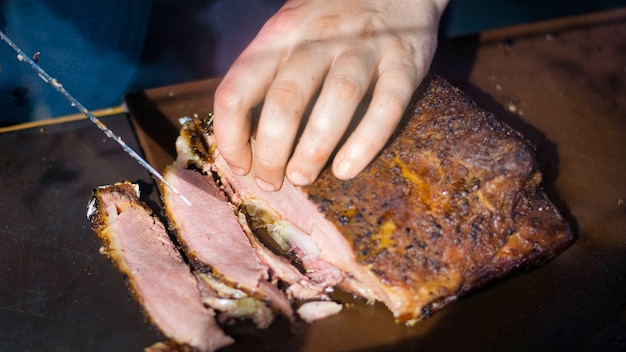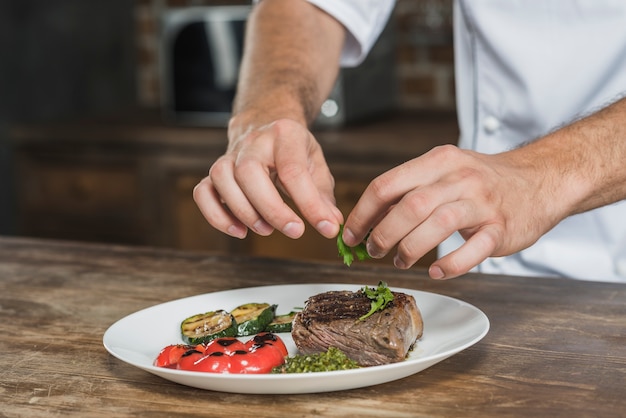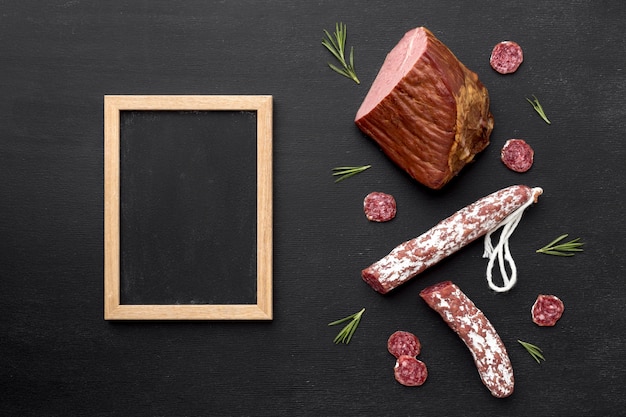Ah, the T-bone steak. A culinary icon, a symbol of indulgence, and a true test of a cook's skills. That glorious combination of tenderloin and new york strip, the eye-catching bone, and the promise of juicy, flavorful bites – it all calls for a perfect cook. But achieving that perfect T-bone isn't just about throwing a steak on the grill and hoping for the best. It's about understanding the nuances of the cut, respecting its strengths, and knowing exactly how to bring out its best. I've been on this journey for years, learning from both successes and a few (okay, maybe more than a few) kitchen mishaps. So, let me share my secrets – my ultimate guide to cooking the perfect T-bone steak.
Part 1: The Foundation – Choosing Your T-Bone

A perfect steak starts with a perfect cut. I've learned that the supermarket isn't always the best place to find that special T-bone. Honestly, the best T-bone I've ever cooked came from a local butcher shop. They take pride in their craft, and they can guide you toward the ideal cut for your cooking method and your taste.
1. The Cut Matters: More Than Just a T-Bone
Think beyond just "T-bone" – there are variations, and they matter! For instance, a "Porterhouse" is essentially a larger T-bone, with a more prominent strip side. Then you have "bone-in ribeye" – that's a thicker, more marbled steak that's cut entirely from the ribeye. Each has its own flavour profile and cooking considerations.
2. Marbling is Your Friend
I can't emphasize this enough: Marbling is key. That's the network of fat throughout the meat, and it's what makes a T-bone so incredibly juicy and flavorful. You want to see good, even marbling throughout, not just concentrated in a few spots. Think of it as a delicious landscape. Ask your butcher for advice if you're not sure.
3. Thickness Matters Too
Don't be afraid to go thick! A good T-bone steak should be at least 1 inch thick, and 1.5 inches is even better. It gives you more room for a beautiful sear and a nice even cook. You can always cut a thicker steak into smaller portions if you prefer.
Part 2: Prepping the Champion

Now that you have your prize-winning T-bone, it's time for the pre-game preparation. It's not just about seasoning; it's about setting the stage for a truly delicious outcome.
1. Pat Dry – A Crucial Step
One of my first cooking lessons, and a simple one, but vital: Pat the steak dry with paper towels. This might seem trivial, but it makes a world of difference when it comes to getting a good sear. A dry surface allows the steak to brown beautifully and develop a crispy crust. If you skip this step, you risk ending up with a steamed steak instead of a seared one.
2. Seasoning: Keep it Simple or Get Creative
The beauty of T-bone steak is that it's a blank canvas. I love the simplicity of salt and pepper, letting the natural flavour shine through. But if you're feeling adventurous, get creative. A blend of herbs and spices – rosemary, thyme, garlic powder, paprika – can add depth and complexity. Don't be afraid to experiment with different combinations.
3. Resting is a Must
Think of this as your steak's warm-up. Before you start cooking, let the T-bone rest at room temperature for about 30 minutes. This allows the steak to come up to temperature evenly, resulting in a more consistent cook. It's a small effort that pays off big time in flavor and texture.
Part 3: The Grand Cook-Off

Okay, it's time for the main event. This is where your careful prep and understanding of the T-bone really come into play.
1. Master the Sear
A perfect sear is essential for a great T-bone steak. It's all about heat, and I prefer a cast-iron pan – it gets incredibly hot and creates a beautiful crust. If you’re using a gas stove, turn the burner to high heat, and give the pan a good 5-7 minutes to preheat. If you're using an electric stove, heat the pan on the highest setting for at least 5 minutes. You want the pan to be so hot that it sizzles when you add a drop of water to it.
Now, gently place the steak in the pan, making sure not to overcrowd it. Don't move it for the first 2-3 minutes. You want that beautiful sear to develop, so let it form a crispy, flavorful crust.
2. Flip It Right
Once you’ve got a beautiful sear on one side, it’s time to flip. Remember, your goal is to cook the steak evenly, so don’t rush the flipping process.
3. Oven Time – The Finishing Touch
Now it’s time to finish cooking the steak in the oven. This helps to ensure that the steak is cooked evenly throughout. Preheat your oven to 350°F (175°C). Place the steak on a baking sheet or in a roasting pan and cook it for the appropriate time, depending on the thickness of the steak and how you like it cooked.
4. The Power of the meat thermometer
Let's talk about that crucial tool – the meat thermometer. It's a game-changer, especially for T-bones. The internal temperature determines doneness, and it's important to get it right. Don’t rely on touch or visual cues. Insert the thermometer into the thickest part of the steak, making sure not to touch the bone.
Remember, you can always cook the steak a little longer, but you can’t uncook it. So it’s better to err on the side of undercooked.
Part 4: Doneness and Temperature
Now that we're ready to cook, let's clarify what each level of doneness means in terms of temperature.
1. Rare (125°F – 130°F)
A rare T-bone has a cool, red center and is incredibly tender. It's for those who appreciate a taste of the raw steak. The inside will be cool to the touch and have a very distinct red color.
2. Medium-Rare (130°F – 135°F)
Medium-rare is my personal favorite. The center will be slightly pink, warm to the touch, and firm. It's a great balance of tenderness and flavor. It's that happy medium that many people enjoy.
3. Medium (135°F – 140°F)
If you prefer a steak that’s cooked a little bit more, medium is a good option. It's the classic “well-done” level of doneness that many people enjoy. The center will be warm, pink, and firm.
4. Medium-Well (140°F – 150°F)
Medium-well has a light pink center and a very firm texture. It's a good option if you want a steak that's more cooked than medium but still has a bit of pinkness to it. It’s a good choice for less fatty cuts of meat.
5. Well-Done (150°F – 160°F)
Well-done steak has a gray center. If you prefer your steak with no pink, then well-done is the way to go. But be warned, well-done steak can be dry and tough, especially when it comes to a T-bone, so it’s best to go with a more tender cut of meat. I typically avoid this unless someone specifically requests it, as it often loses its juiciness and flavor.
Part 5: Resting and Serving
The final act in this culinary drama is letting the T-bone rest. It's crucial to let it rest for at least 10 minutes before slicing and serving. Why? It allows the juices to redistribute evenly throughout the steak, resulting in a much more tender and flavorful bite.
1. Slicing and Serving
Now that your T-bone has rested, it's time to slice it and get ready to serve. I like to cut the steak against the grain, which means slicing perpendicular to the muscle fibers. This makes it easier to chew and allows the flavors to develop.
2. The Sides That Complete the Story
A T-bone steak is a showstopper, but it’s best paired with the right supporting cast. Think of the sides as the characters that complete the story of your meal. I love a mix of textures and flavors – something creamy, something crunchy, and something bright. Here are some of my favorites:
- Roasted vegetables: roasted asparagus, broccoli, or Brussels sprouts bring a delightful char and sweetness.
- Creamy mashed potatoes: A classic for a reason, mashed potatoes provide a comforting and creamy contrast.
- Green salad: A refreshing and light counterpoint to the richness of the steak. I like to use a vinaigrette dressing for a light and tangy touch.
- Mac and cheese: For a cheesy, comforting side, mac and cheese is a perfect pairing.
- grilled corn on the cob: A delicious and summery side, grilled corn is perfect for barbecue.
3. Sauces and Toppings for Extra Magic
Don't stop there! You can also add a touch of extra flavor to your steak with a sauce or topping. I love a simple pan sauce made with butter, garlic, and herbs. It's the essence of classic steakhouse flair. But you can also get creative with a red wine reduction, a creamy mushroom sauce, or even a bold chimichurri.
For toppings, I recommend a dollop of horseradish cream, a sprinkle of fresh herbs, a slice of lemon, or a drizzle of balsamic glaze. It’s all about finding the flavors that you love.
Part 6: Tips and Tricks for Success
Here are a few extra tips to ensure your T-bone steak is the culinary star of your next gathering.
1. Don't Overcrowd the Pan
If you're cooking multiple steaks, avoid overcrowding the pan. It’s better to cook them in batches to ensure they get a good sear. The pan needs to be hot enough to sear the steak without overcooking it. If you overcrowd it, the temperature of the pan will drop, and you won't get that nice, even sear.
2. Let It Rest, Really Rest
We’ve already talked about letting the steak rest, but it's worth repeating. It's a critical step! It allows the juices to redistribute throughout the meat, resulting in a much more tender and flavorful steak.
3. Embrace the Meat Thermometer
A meat thermometer is your best friend when it comes to cooking steak. It’s the most reliable way to ensure your steak is cooked to your liking. It’s a small investment that will pay off in consistently cooked steaks.
4. Don't Be Afraid to Experiment
Cooking T-bone steak is all about experimentation. Try different seasoning blends, sauces, and sides. You never know what new flavor combinations you might discover. Have fun with it!
Part 7: Mistakes to Avoid
We've all been there, those moments in the kitchen when we feel like we've committed a culinary crime. Here are some common T-bone steak mistakes to steer clear of.
1. The Sin of Overcooking
This is the cardinal sin of T-bone cooking. Overcooked steak is dry, tough, and flavorless. It's a tragedy waiting to happen. Use a meat thermometer to ensure your steak is cooked to your liking, and err on the side of undercooked. You can always cook it a little longer, but you can’t uncook it.
2. A Half-Hearted Sear
A good sear is crucial for a flavorful T-bone steak. Make sure the pan is screaming hot and don’t move the steak around too much when you’re searing it. You want to give it time to develop a nice crust. The crust gives it that great flavour that you can’t get from just cooking it in the oven.
3. The Restless Cook
Patience, my friend. Letting the steak rest is crucial. It allows the juices to redistribute, resulting in a more tender and flavorful steak. It's the final step in bringing your T-bone masterpiece to life.
Part 8: FAQs
You have questions, I have answers. Here’s a roundup of some common questions about cooking T-bone steak.
1. How do I know if my steak is done?
The best way to know if your steak is done is to use a meat thermometer. Insert it into the thickest part of the steak, but not touching bone. The temperature should be 125°F-130°F for rare, 130°F-135°F for medium-rare, 135°F-140°F for medium, 140°F-150°F for medium-well, and 150°F-160°F for well-done. You can also use a touch test, but it’s less accurate than using a meat thermometer.
2. Can I cook a T-bone steak on the grill?
Absolutely! Grilling is a great way to cook T-bone steak. Just make sure the grill is hot and that you’ve got a good sear. You can also use indirect heat to finish cooking the steak. I like to put a little wood chips on the coals for a smoky flavor.
3. Can I freeze a T-bone steak?
Yes, you can freeze a T-bone steak. Wrap it tightly in plastic wrap or aluminum foil before freezing. It’s best to thaw it in the refrigerator overnight. Frozen steak will be more tender if it is cooked slowly. It won’t be quite as good as fresh steak, but it’s still a good option if you’re in a pinch.
4. What’s the best way to store a T-bone steak?
For the best results, store your T-bone steak in the refrigerator for up to 5 days. It’s best to keep it on a plate lined with paper towels and wrapped in plastic wrap. This will help absorb any excess moisture and keep the steak fresh.
5. What can I do with leftover T-bone steak?
Leftover T-bone steak is perfect for making a delicious steak salad, sandwiches, or even a hearty pasta dish. You can also slice it thinly and use it in tacos or burritos. It's a versatile ingredient that you can use in many different ways.
There you have it! My guide to cooking the perfect T-bone steak. It’s a journey that takes practice, but with these tips and tricks, you’ll be creating delicious steak dinners that impress. So next time you’re craving a special meal, go for the T-bone – you won’t regret it!
Everyone is watching

How to Cook Frozen Lobster Tails Perfectly: A Step-by-Step Guide
RecipesLobster. Just the word conjures up images of lavish meals, special occasions, and a taste of luxury. But let's...

Pigs in a Blanket Cooking Time: How Long to Bake for Perfect Results
RecipesAh, pigs in a blanket. Just the name conjures up images of those delightful little parcels of crispy pastry en...

Pork Fillet Cooking Time: How Long to Cook It Perfectly
RecipesPork fillet, or tenderloin as it's sometimes called, is a real favourite in our house. It's so versatile, and...

The Ultimate Guide to Tender, Juicy Pulled Pork
RecipesRight, let's talk pulled pork. It's one of those dishes that just screams "comfort food," doesn't it? I mean...

The Ultimate Guide to Cooking Sweet Potatoes: From Roasting to Mashing
RecipesSweet potatoes. Just the name conjures up images of warm, comforting dishes, bursts of vibrant color, and a to...
